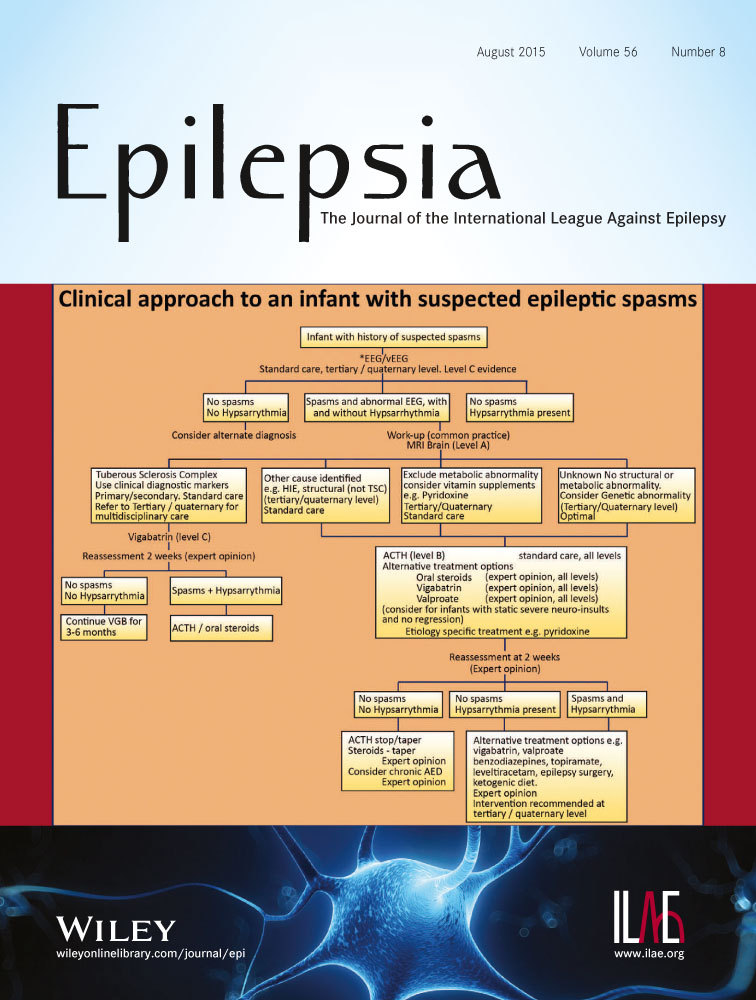Summary of recommendations for the management of infantile seizures: Task Force Report for the ILAE Commission of Pediatrics
Summary
Evidence-based guidelines, or recommendations, for the management of infants with seizures are lacking. A Task Force of the Commission of Pediatrics developed a consensus document addressing diagnostic markers, management interventions, and outcome measures for infants with seizures. Levels of evidence to support recommendations and statements were assessed using the American Academy of Neurology Guidelines and the Grading of Recommendations Assessment, Development and Evaluation (GRADE) system. The report contains recommendations for different levels of care, noting which would be regarded as standard care, compared to optimal care, or “state of the art” interventions. The incidence of epilepsy in the infantile period is the highest of all age groups (strong evidence), with epileptic spasms the largest single subgroup and, in the first 2 years of life, febrile seizures are the most commonly occurring seizures. Acute intervention at the time of a febrile seizure does not alter the risk for subsequent epilepsy (class 1 evidence). The use of antipyretic agents does not alter the recurrence rate (class 1 evidence), and there is no evidence to support initiation of regular antiepileptic drugs for simple febrile seizures (class 1 evidence). Infants with abnormal movements whose routine electroencephalography (EEG) study is not diagnostic, would benefit from video-EEG analysis, or home video to capture events (expert opinion, level U recommendation). Neuroimaging is recommended at all levels of care for infants presenting with epilepsy, with magnetic resonance imaging (MRI) recommended as the standard investigation at tertiary level (level A recommendation). Genetic screening should not be undertaken at primary or secondary level care (expert opinion). Standard care should permit genetic counseling by trained personal at all levels of care (expert opinion). Genetic evaluation for Dravet syndrome, and other infantile-onset epileptic encephalopathies, should be available in tertiary care (weak evidence, level C recommendation). Patients should be referred from primary or secondary to tertiary level care after failure of one antiepileptic drug (standard care) and optimal care equates to referral of all infants after presentation with a seizure (expert opinion, level U evidence). Infants with recurrent seizures warrant urgent assessment for initiation of antiepileptic drugs (expert opinion, level U recommendation). Infantile encephalopathies should have rapid introduction and increment of antiepileptic drug dosage (expert opinion, level U recommendation). There is no high level evidence to support any particular current agents for use in infants with seizures. For focal seizures, levetiracetam is effective (strong evidence); for generalized seizures, weak evidence supports levetiracetam, valproate, lamotrigine, topiramate, and clobazam; for Dravet syndrome, strong evidence supports that stiripentol is effective (in combination with valproate and clobazam), whereas weak evidence supports that topiramate, zonisamide, valproate, bromide, and the ketogenic diet are possibly effective; and for Ohtahara syndrome, there is weak evidence that most antiepileptic drugs are poorly effective. For epileptic spasms, clinical suspicion remains central to the diagnosis and is supported by EEG, which ideally is prolonged (level C recommendation). Adrenocorticotropic hormone (ACTH) is preferred for short-term control of epileptic spasms (level B recommendation), oral steroids are probably effective in short-term control of spasms (level C recommendation), and a shorter interval from the onset of spasms to treatment initiation may improve long-term neurodevelopmental outcome (level C recommendation). The ketogenic diet is the treatment of choice for epilepsy related to glucose transporter 1 deficiency syndrome and pyruvate dehydrogenase deficiency (expert opinion, level U recommendation). The identification of patients as potential candidates for epilepsy surgery should be part of standard practice at primary and secondary level care. Tertiary care facilities with experience in epilepsy surgery should undertake the screening for epilepsy surgical candidates (level U recommendation). There is insufficient evidence to conclude if there is benefit from vagus nerve stimulation (level U recommendation). The key recommendations are summarized into an executive summary. The full report is available as Supporting Information. This report provides a comprehensive foundation of an approach to infants with seizures, while identifying where there are inadequate data to support recommended practice, and where further data collection is needed to address these deficits.




